Note: This article aims to contribute informative content for you. I present this, based on my opinion. I am not responsible for your gains or losses. When you finish reading, do your study and invest at your own risk.
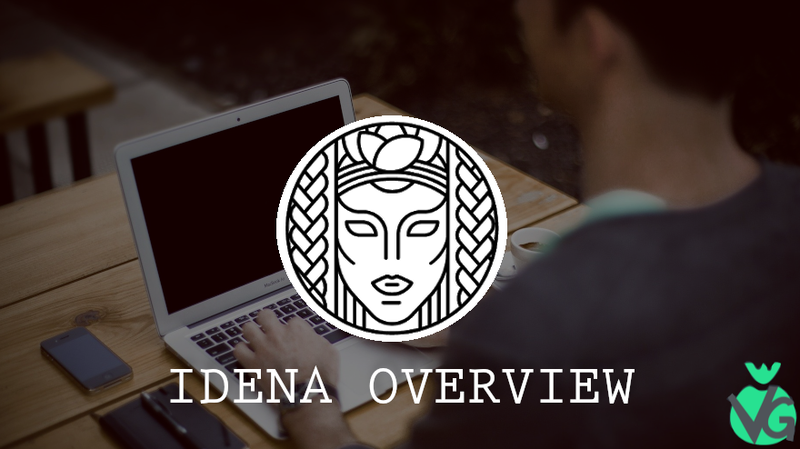
"Bitcoin is innovative". You have probably been told or heard it somewhere, but know that Bitcoin is a combination of already existing elements of cryptography to be a cryptocurrency. That is, basically a form of electronic money that uses cryptography to work.
One of these elements is Proof Of Work. It was conceived in 1993 by Cynthia Dwork and Moni Naor when they published an article, proposing a new method of combating spam emails, through functions linked to memory. The sender of the email should perform a proof of work via the CPU, spending, for example, a few seconds, "solving a mathematical problem" before sending the message.
The term proof of work appeared in 1999 with the article by Markus Jakobsson and Ari Juels: "Proofs of work and bread pudding protocols". It was characterized by the notation of a proof of work (PoW), a protocol, where the tester demonstrates to the tester that he spent some computational effort in a specific time interval. But, until then this was not popular.
That's when in 2008, Satoshi Nakamoto published the Bitcoin whitepaper, popularizing the term Proof-of-Work (Pow). So, how does it work, in general, currently, when it comes to cryptocurrencies? Well, proof of work is a consensus algorithm were miners, with their mining machines, need to solve complex mathematical calculations, with their computational power, to validate transactions on the network.
This model was thought of as a way to add security to the network, but in practice, depending on how centralized this computational power is, the so-called 51% attack can occur. Where a miner or a group holds the majority of hashrate power, making it possible to roll back transactions, carry out double-spending practices, DDOS or prevent other miners from continuing their work, monopolizing mining.
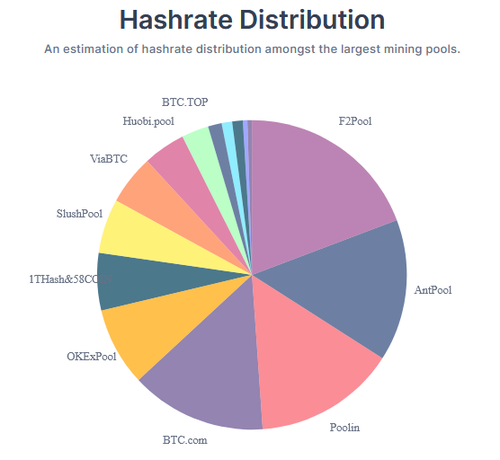 <grammarly-extension class="_1KJtL" style="position: absolute; top: 0px; left: 0px; pointer-events: none; z-index: 1;">
<grammarly-extension class="_1KJtL" style="position: absolute; top: 0px; left: 0px; pointer-events: none; z-index: 1;">The likelihood of a 51% attack happening on the bitcoin network is very small. Due to the magnitude of the network and the fact that the investment necessary to carry out such an act would be almost impossible. But there is a certain centralization of hashrate power in a small group of pools that would already add up to almost 50% of the hashrate.
In the world of cryptocurrencies, the centralization of power is common, even though the main idea is the search for decentralization. Truly decentralized projects are rare. This centralization can occur in several ways, either by holding the largest hashrate or the majority of the number of coins in circulation, for example, in coins that use the proof of stake consensus algorithm, whoever holds the most coins, tends to get more staking rewards. But what if everyone who wanted to join the network was important, and if there was more democracy on the network? Well, know, in this article, the cryptocurrency Idena.
What is Idena?
Idena is a cryptocurrency project that seeks to innovate, introducing a new consensus protocol: Proof-of-Person. Each node in the network is represented by a cryptoidentity, a single person with equal voting power, democratically. But don't worry, you don't need a KYC or send documents to prove your humanity.
New identities are verified through a Turing AI-hard test performed at the same time by everyone around the globe. You need to resolve and analyze flips in this validation session. But, what are flips?
Flips
For some, it is like a simple challenge. For others, a form of art expression whose meaning would be something, in my view, like: "Hey, I'm human, I can do it". But without delay, it is a set of images, forming a story, based on a pair of random words, provided by the client. You need to choose the set of images that makes the most sense.

The validation session
The validation session is a frequent and necessary event for the network to function. It is from there that potential candidates if they pass the session, will become validated newbies. And as the seasons pass your rank/status changes. To become a candidate, you need to activate invitation codes on the client.
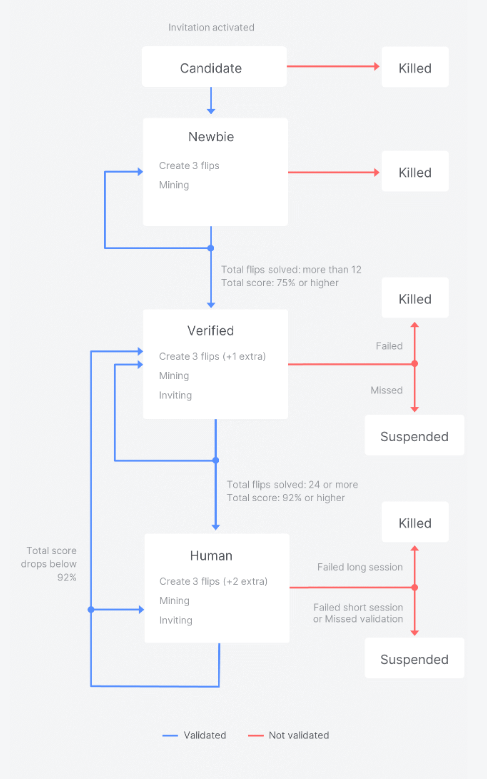
The session starts, presenting, first, 6 flips that need to be solved in less than 2 minutes. You must resolve these first flips! Next is the process of checking the flips that have been sent by the community. Here in the long session, you have a lot of time compared to the short session, as you have more flips to solve and check if the flips are related to the keywords presented.
Check out a video showing the validation session:
After validation, you will receive rewards according to your activity on the network, for example, How many flips you have made, how many new identities you have invited, and so on … Don't forget to comment on what you found on Discord or Telegram. The community gets together to discuss and complain about nonsense flips, show the score among other things, the post-validation ritual.
Mining
After passing the validation session, you will be able to complete the mining process. Unlike other cryptocurrencies, where a huge computational power is needed, here you just leave the wallet open, with the status of online mining on, you already earn a little, helping to validate transactions.
Do not forget to disable the mining status when closing the wallet, because if you spend more than 1 hour with the wallet closed and have forgotten to disable the status, you will suffer a mining penalty, calculated based on the size of the network.
Team
Idena's team is anonymous, present in the crypto world since 2015. The fact that they are anonymous is since they do not want this to become a flawed point in the future and that the protocol must remain alone without the main team.
There are 5 developers on the main team. Also, there are developers from the community who help create applications that work on the Idena network: @endogen, @realRioda, @menxit, @bingbinglee1, @Angainor, @ProjXDev, and many others…
Use cases
As initially, Bitcoin was designed for P2P transactions and Ethereum for smart contracts and dapps, defi, and DAO. Idena would be more centered, on the issue of cryptoidentity, in terms of voting, digital governance, the foundation of community projects, and other useful tools for people around the globe, but not limited to just that. Other applications such as decentralized messenger, decentralized publishing platform, and other dapps could also be implemented on Idena's network.
Technical specifications
Symbol: DNA
Testnet genesis block: 1 August 2019
Consensus: Proof of Person (PoP)
Block time: 20 seconds
Block reward: 6 DNA
Mining reward per day: 25,920 DNA
Validation reward per day: 25,920 DNA
Max supply: Unlimited
Premine: 36,000,000 DNA
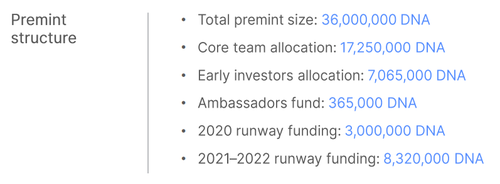
The supply of DNA is not limited. The total coin creation per day is 51840. Half of this is mined while producing blocks. The rest is minted during the validation sessions.
Block reward: 6 DNA
Maximum number of blocks per day: 4,320
Mining cap per day: 25,920 DNA (50%)
Accumulating fund per day: 25,920 DNA (50%)
Total cap: 51,840 DNA
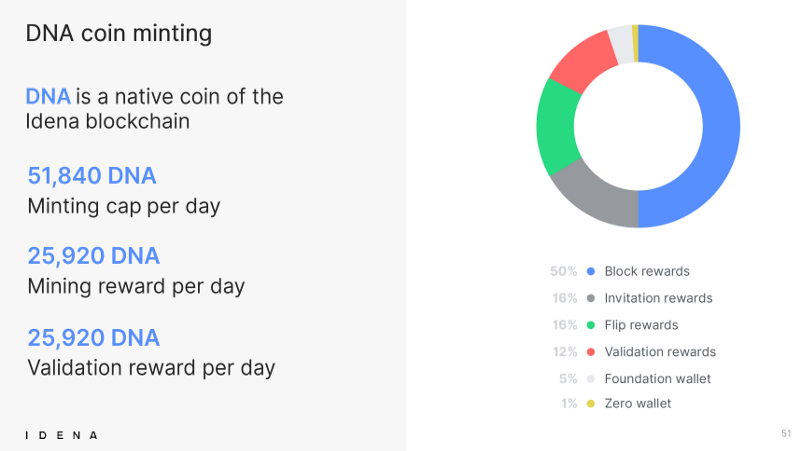
Well, that's it. There was still much to say, but I tried to highlight the main things. You can consult the links below for more information and ask questions about the project on the community's social media. Leave your comment about the project/article. If you are interested, start now and request your invitation code from the groups, then just wait for the next validation session.
Official Links
Site: https://idena.io
Coingecko: https://www.coingecko.com/en/coins/idena
Discord: https://discord.gg/96Sw2e6
Telegram: https://t.me/IdenaNetworkPublic
Comments